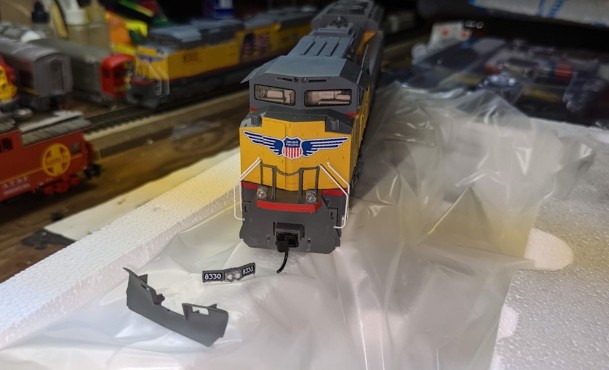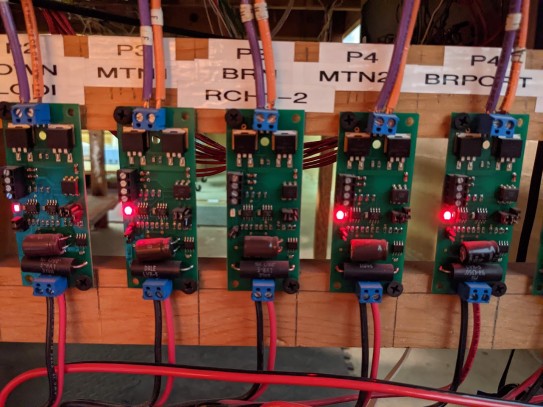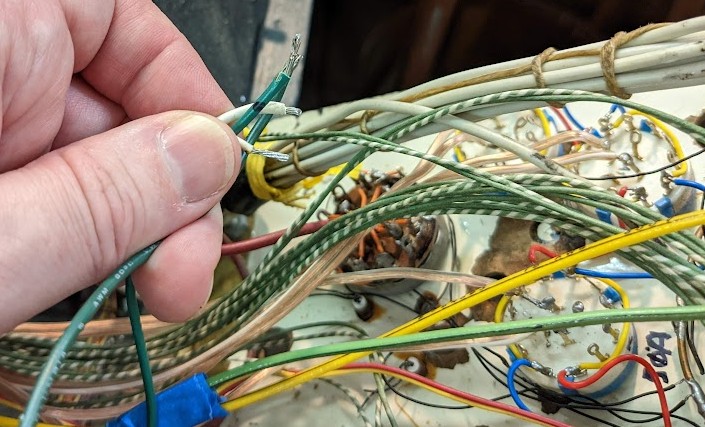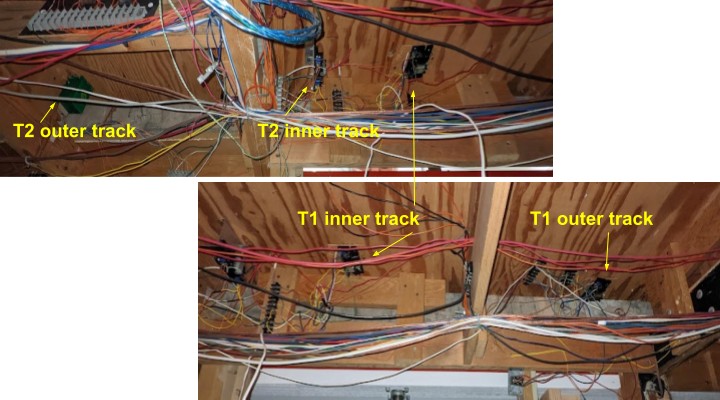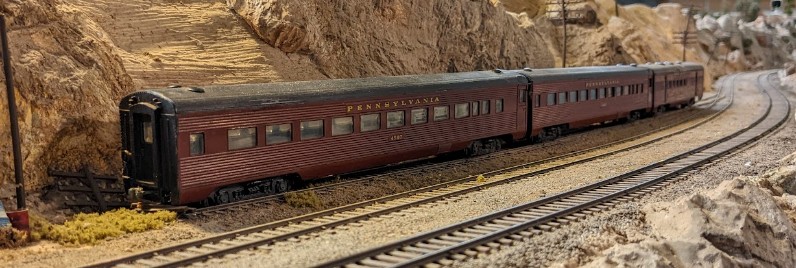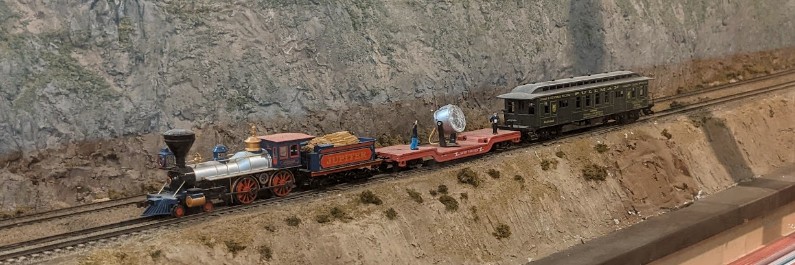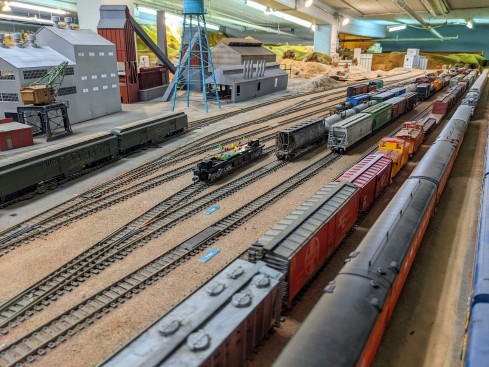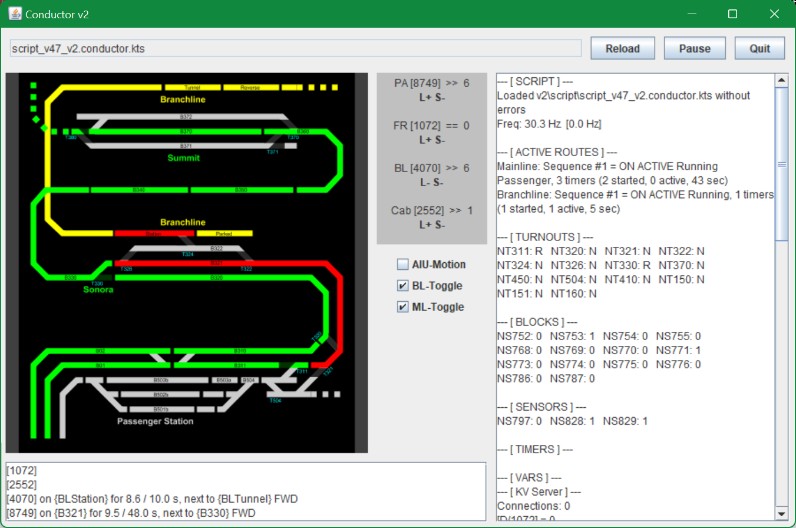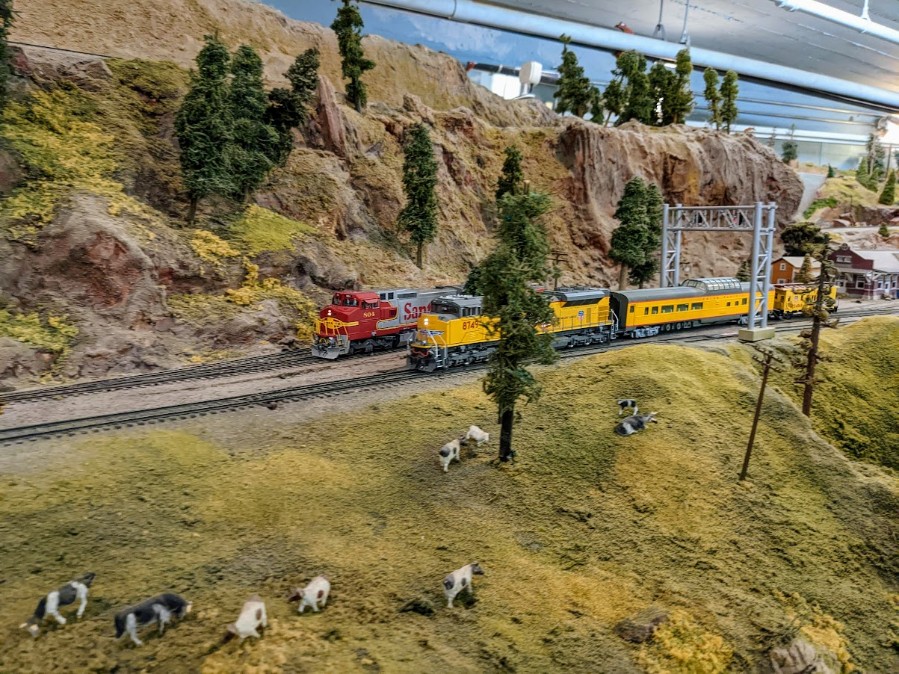The Randall Museum in San Francisco hosts a large HO-scale model railroad. Created by the Golden Gate Model Railroad Club starting in 1961, the layout was donated to the Museum in 2015. Since then I have started automatizing trains running on the layout. I am also the model railroad maintainer. This blog describes various updates on the Randall Museum Model Railroad and I maintain a separate tech blog for all my electronics & software not directly related to Randall.
Affected |
Turnout T111 (after Fairfield station, arriving at Lodi). |
Description |
Specific steam engines stop-and-go on the turnout. |
Summary Fix |
Power the switch rail. |
Description of Issue
We’ve had some specific steam engines derail on Turnout T111 in the past. In the last repair attempt, it was identified the switch rails were loose because there is no turnout throw rod at all. Previously the point rails were spiked, then glued, and that addressed some of the issues for a while.
However most BLI steam engines still stop-and-go on that turnout. An annoying feature of the BLI engines is that they stop when they lose power (ok, that’s understandable) but then they speed up as soon as they cross the dead spot. When doing so, the engines typically have a jerking motion that either derails the steam engines complicated wheelsets, or derails the attached cars, or both.
Click here to continue reading...
Once I was done cleaning the track, I started looking at the new Walthers SD70ACe UP engines I got for the automation. They need a bit of break in before I put them on automation.
Out of the box, I was disappointed to see both engines were lacking the nose headlight & number plates. These were in the box. One of the snowplows was also off. I’ll need to glue them both back correctly -- the last thing I want is for a loose part to come off when running in automation.
UP 8312 and UP 8330 came with a snowplow and the number plates fallen in the box.
It became quickly clear there were a number of issues with these engines.
I wrote a full description of the Walthers Mainline SD70ACe issues on the other blog.
I was cleaning the balloon track on the Napa yard this morning, and realized the “DCC Dead Spot Detection Car” I made was very useful: the LEDs come on or off when the track has no conductivity. When the train runs, they sort of “blink”, and that can give us a real sense of how dirty the track is.
I tried a few variations on the train composition. What works best for normal cleaning is:
- Roller car goes first,
- Followed by engine,
- Then the DCC detection car,
- Finally one or two pad cars.
When the track is really dirty, both the roller car and the pad car go in front of the engine.
To clean tracks that haven't been cleaned in years, I typically use several freight cars as buffers between the cleaning cars and the engine, and I try to even avoid the engine getting on the track to clean if possible.
I’ve noticed a couple times in the last few weeks that the automated Branchline train did not run, yet then it inexplicably started working fine the next day. Normally when the automation stops, it’s due to the train having derailed, which is not a situation that fixes itself automagically.
Of course, then I show up the day after at the layout and things work just fine, so it makes it hard to guess where the failure was. Today I noticed that it was one of these days where the branchline automation was not running. And since I was at the museum, I took a look and started with the silent branchline train. Was the engine derailed? Nope. Was it responding to DCC commands? Nope. Huh, wait, is there power to the track? Nope. Aha, that’s our problem!
A quick look at the NCE EB1 circuit breakers, and it’s obvious something is wrong:
“P3 BRN RCHM-2” is the sweet designation of the EB1 that controls the Branchline power district. That LED being off is a problem. And measuring it, we have ~13.5V DCC on the input and nothing on the output. So that’s the likely culprit.
I don’t really have a spare EB1 right now because, duh I used them all. But that’s ok, I can borrow the one from Fairfield which is not currently being used. After the annoying task of trying to fit the obviously too large gauge wires in the obviously too small EB1 terminals, I got the thing working in a short time:
Click here to continue reading...
2022-09-19 - Automation Updates
Category RandallThe automation runs 7 hours a day, 5 days a week. That's a lot of runtime for HO train engines which are not designed to run that much in their entire lifetime.
Consequently, for each mainline automated train, I have 2 similar engines with the goal of swapping them on a regular basis. I've done the UP engine a few times yet I have not rotated the Freight train engines in a while, and I finally got around to it today:
NS 1072 Heritage “Illinois Terminal” is back on Freight automation.
On the Branchline side, Santa Fe 804 has been behaving neatly and I just added a car and a caboose to it:
I'll need to carefully monitor that for the next few days to ensure this combo does not derail. The branch line track can be very finicky in a couple of specific places.
Allen and I started looking at what it would take to fix the mainline crossover T1-T2 in front of Stockton Station.
From my notes back from 2017, one side has a broken switch rail, and the other side has no power on the frog, and something in there was shorting when thrown.
First, which is T1, and which one is T2? Turnouts on the Stockton Yard side go form T6 down to T3. Thus it makes sense the next one is T2 from the yard, followed by T1, away from the yard. I will need to label them on the layout fascia to remember that. I have an older track plan with the turnouts labels inverted, and then a newer one with them correct:
The toggle on the panel did not operate, and after a while I remember I had powered off the entire turnout panel because something was shorting all turnouts in there. And we don’t really use the panel, so fine, it’s basically unpowered. Looking behind, it’s quite a jungle in there:
Each time I open this panel, I want to tear apart all this mess and clean it up.
In that picture I’m holding the 2 wires for both T1 and T2. 2 green wires and 2 white ones. Each turnout has one green and one white, but which ones pair together? No clue. I took an educated guess at which 2 wires are likely to pair together and marked these with black marker, and of course I don’t know if that’s for T1 or T2.
I thus spend the next 15 minutes crawling under the layout trying to follow one of these wires. It was a bit of a painful chase as the wire went through a convoluted non-direct route starting in the opposite direction of the turnout!
After a while I traced this to T2. Here’s what we have under the turnout:
The important data I needed to see here is that:
- T2 has one Tortoise (outer track) and one Fulgurex (inner track).
- T1 has 2 Fulgurex.
T2 is the one with the broken switch rail, which I don’t know how to fix, so we’ll put it aside.
T1 is the one I care most about. If I could get it to work, it would allow us to get out of the yard using the inner track and easily move to the outer track. Powering up the turnouts using the 2 green+white wires from the turnout panel did not do anything, so now I need to poke them in-situ with a 12 V power supply to verify whether the turnout motors actually work.
2022-09-11 - Photo Gallery
Category Randall
Spokane Portland & Seattle 4369 & 4070 (Alco C636 & RS-3) [photo Jim Evans]
A Pennsy passenger train with a GG-1 on the point at Stockton Station.
A few more PRR cars in storage on the Walong spur.
The Jupiter 4-4-0 and its search party has been spotted next to the Sultan tunnel.
Here’s the result of an afternoon of work with Allen:
What you do not see here are the little blue tape markers that were condemning some of the yard tracks since 2017 and 2018. More on that below.
First I’ve reworked my DCC Dead Spot Detection Car, and it’s worth explaining what I did to fix its electrical pickup issues.
Click here to continue reading...
I’ve spent the last couple months mostly working on a new version of my automation software: Conductor 2. The new version has an entire new scripting language, advanced logic for block handling, and a simulator.
It’s almost ready for trial at the museum. For now, it works neatly using the simulator:
I have detailed updates about Conductor 2 on the technical blog here.
I also have updated RTAC, the Android software that runs on the tablets at Randall. These are mostly little implementation technical details, and not directly visible to the visitors. The latest version of RTAC is now available on the Google Play store.
Back in May, I was very happy to have placed this SP&S Alco RS-3 #4070 on the Branchline. What’s not to love about it, it’s an RS-3, and the Portland scheme is gorgeous, and it had a matching caboose with directional marker lights.
Eventually last week it just stopped working. But oddly enough, it stopped working just on the Branchline. The same engine works well when directly addressed on the programming track or on the Mainline, but then once on the Branchline, all I get is sound and no movement. That’s… puzzling.
Instead I picked up that Santa Fe 804 engine I had been using for track cleaning. It works well. Tested it on the Branchline and it survived the very finicky track. Here’s a nice shot where the automation train was reaching the branchline line. Compare with real pictures of the GE C40-8W ATSF #804 vs the EMD SD70ACe UP #8749.
I’m amazed 804 can navigate that track without falling all over itself. It’s quite a remarkable model. I love it.
Click here to continue reading...

